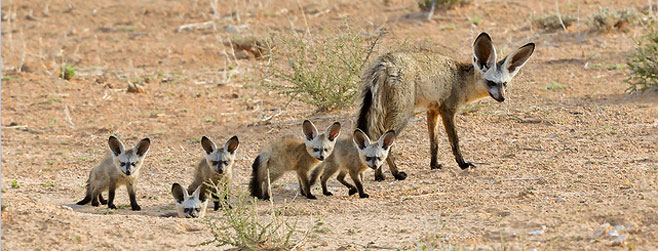|
Otocyon megalotis (Bat-eared fox)
Delalande's fox [English]; bakoorvos, bakoorjakkals, draaijakkals [Afrikaans]; Löffelhund
[German]; otocyon [French]; bweha masigio [Swahili]; unga [isiNdebele]; impungutye
[isiXhosa]; udlamWoshana [isiZulu]; motlhose [Sepedi]; phokojwe e ditsebe tsa
mankgane, motlhose [Sesotho]; motlhose, motlhose, letlhose, tlhose, tlhOsi [Setswana];
udlamWoshana, imphungushe [siSwati]; xilwanandau, xilwa-na-ndzawo [Xitsonga];
phunguhwe i re na ndevhe khulwane [Tshinvenda]; ||Āb
[Nama] [Damara]
Life
>
Eukaryotes >
Opisthokonta >
Metazoa (animals) > Bilateria > Deuterostomia >
Chordata > Craniata > Vertebrata (vertebrates) >
Gnathostomata (jawed vertebrates) > Teleostomi (teleost
fish) > Osteichthyes (bony fish) > Class:
Sarcopterygii (lobe-finned fish) > Stegocephalia
(terrestrial vertebrates) > Reptiliomorpha > Amniota >
Synapsida (mammal-like reptiles) > Therapsida > Theriodontia
> Cynodontia > Mammalia (mammals)
> Placentalia (placental mammals) > Laurasiatheria
> Ferungulata > Ferae > Carnivora > Family:
Canidae (foxes, dogs and jackals)
Identification
The name Bat-eared fox originates from their large bat-like ears,
used for hearing and to give off body heat. This species is small
and jackal like in appearance with slender black legs and a black
sharp-pointed muzzle. A light or white band runs across the forehead
to the base of the ears. The coat is silver-gray, and longish with a
grizzled appearance. The tail is long and bushy, black on top and
near the tip. They are not jackals, but the Afrikaans names are
Bakoorjakkals or draaijakkals. Draaijakkals describes how it runs as
it twists and dodges and can turn quickly on its own track.
Size
Total Body Length: 75-90 cm; height at shoulder
35 cm; weight range 3 -5 kg.
Dentition
The jaws are not very strong and the teeth are
small and weak. But they have lots of teeth varying from 46 to 50,
with between 4 and 8 extra molars for grinding. The bat-eared fox
has more teeth than any other mammal. Mastication (chewing) is very
fast and prey is well chewed. A step-like protrusion, the subangular lobe, on the lower jaw
anchors the large digastric muscle. This causes a quick chopping jaw
action with very little side-to-side movement.
Dental formula:
I C C P P M M =
46 or 50 =
46 or 50Distribution and habitat
Widespread in western and central areas of the
southern African subregion. It prefer areas of short grass or bare
ground in open grassland or scattered shrubland
General behaviour
Bat eared foxes are active mainly at night
(nocturnal) but are seen during the morning or evening, avoiding the
heat of the day by sheltering in thick shrub, tall grass areas or
burrows. It is an active digger and will excavate its own burrows,
but often modifies those dug by another species. It is normally
silent, but communicates with soft contact calls, whines and chirps.
It uses a loud bark when alarmed.
Food
Bat-eared
foxes locate their prey primarily by hearing. While foraging it
stops periodically with head cocked and ears pointing to the ground,
listening for the sounds of grubs and termites below the surface. It
then leaps forward and digs shallow holes with its fore paws. The
claws on the forefeet are long and ideal for digging in even the
hardest soil. An insect eater, it is the only carnivore to have
largely given up eating mammalian prey. They cannot tackle big prey.
A large part of diet consists of termites
and dung beetles, other prey items include insects, millipedes and
centipedes, scorpions, spiders, fruits, eggs, snakes, lizards,
frogs, occasional small mammals, birds and soft tubers and roots.
Reproduction
Pairs mate for life (monogamous), and family groups consist of
parents and their offspring. Different family groups may mix
together when feeding. The gestation period is about 50 days long;
litters of two to five cubs are born in underground dens from
October to January, dispersing in June or July.
 |
|
Bat-eared fox with cubs, Kgalagadi Transfontier
Park, South Africa. [photo
Callie de Wet ©] |
Conservation
Predators occasionally include large raptors and caracal and they
succumb to diseases such as rabies and distemper. Their resemblance
to jackal leads to conflict with stock farmers who falsely accused
of them of killing live stock and regard them as vermin. They also
become victims of traps set for problem animals and large numbers
are killed on the roads. Currently the species is not regarded as
threatened but there is the future threat of loss of suitable
habitat due to human activities, building, farming, etc.
Text by Denise Hamerton |
